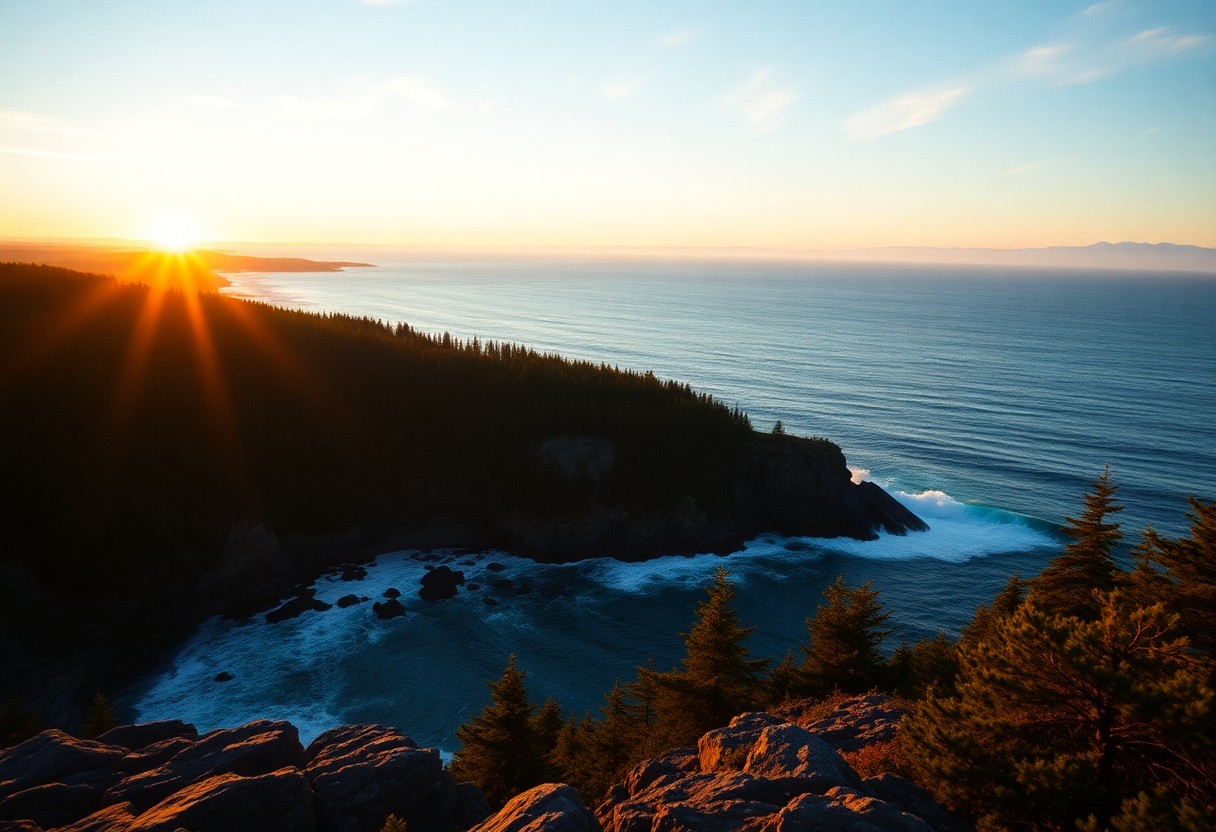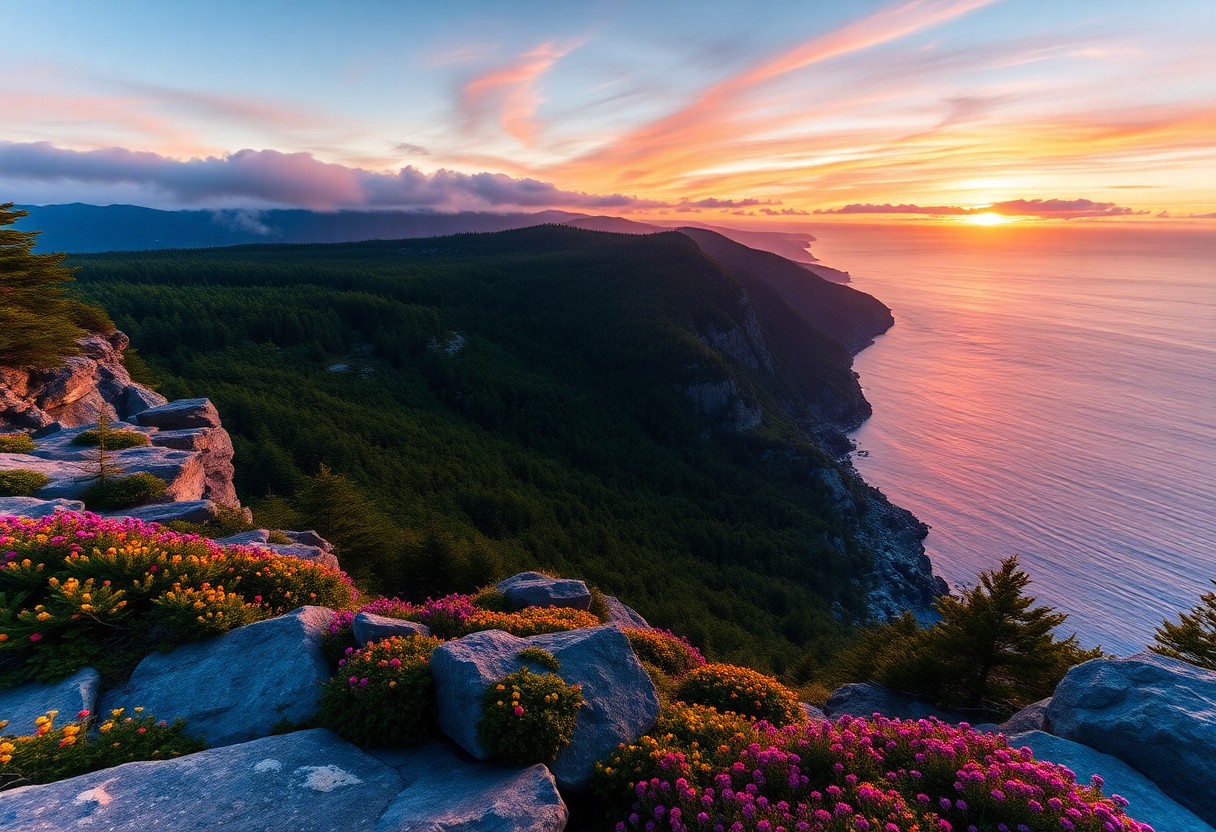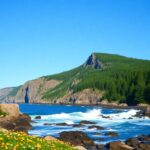
Acadia’s allure lies in its dramatic blend of rugged coastline, dense forests, and granite peaks, such as Cadillac Mountain, the highest point on the U.S. Atlantic coast at 1,530 feet. You can capture the sunrise here before it reaches anywhere else in the country during certain months. The park’s 27 miles of rocky shoreline offer endless vantage points, from Thunder Hole’s crashing surf to Sand Beach’s quartz sands. Each season creates a unique palette, whether the fiery foliage of autumn or the reflective ice patterns in winter, making every visit a fresh photographic adventure.
Key Takeaways:
- Acadia National Park offers breathtaking coastal landscapes perfect for capturing stunning photographs.
- The park features diverse natural elements, including rugged shorelines, dense forests, and granite peaks.
- Sunrise and sunset at spots like Cadillac Mountain provide exceptional lighting for dramatic shots.
- Visitors can explore various trails and scenic overlooks to find unique perspectives and compositions.
- Wildlife and seasonal changes add dynamic and captivating details to photographic opportunities.
Picture-Perfect Locations That Capture Acadia’s Essence
As you explore Acadia, countless views beckon your lens, each revealing a unique facet of the park’s rugged beauty. Whether capturing azure waters lapping at rocky shores or golden light filtering through spruce and fir, you’ll find settings ripe for compelling compositions. Focus on the interplay between natural textures—weathered granite, glassy ponds, sturdy pines—and shifting skies. These elements combine to form images that truly embody Acadia’s spirit, inviting you to tell its story through your photographs.
Cresting Cadillac Mountain: Dawn’s First Light
Standing atop Cadillac Mountain at daybreak offers an unrivaled photo opportunity, as you witness the East Coast’s earliest sunrise cascade across sweeping vistas. The warm glow bathes islands, forests, and ocean in amber hues, creating a dramatic contrast against lingering morning mist. Timing your shot just right, you can capture that fleeting moment when shadow and light dance on the rugged terrain, forging images filled with depth and emotion.
Tranquility at Jordan Pond: Reflections in Nature
Jordan Pond’s crystal-clear waters provide a mirror-like surface that beautifully reflects the surrounding mountains and sky, framing your photographs with natural symmetry. Early mornings, especially, bring calm conditions ideal for capturing still reflections of the iconic Bubble Mountains. Incorporate the vibrant greens of nearby foliage or the subtle ripples caused by gentle breezes to add layers of visual interest.
Expanding on Jordan Pond’s photographic allure, you’ll find seasonal shifts dramatically alter its mood. Fall peppers the landscape with fiery reds and golds, enhancing reflections with vivid color palettes. Winter’s icy glaze transforms the pond into a minimalist canvas awaiting your creative eye. The surrounding trails allow for varied vantage points, enabling you to experiment with angles that highlight both expansive panoramas and intimate nature details.
The Tumult of Thunder Hole: Seascapes in Motion
Thunder Hole offers a powerful display of ocean energy as waves crash into narrow rock fissures, sending explosive sprays skyward. Your photos can capture this dynamic motion, blending the textured stone with frothing surf to convey nature’s raw force. Coastal lighting during tidal surges produces striking contrasts, emphasizing the dramatic interplay of water and rock.
Diving deeper into Thunder Hole’s photographic potential, timing your visit with high tide allows you to seize the maximum impact of water thrusting through the cavernous opening. Slow shutter speeds can blur the water’s motion for an ethereal effect, while fast speeds freeze droplets in midair, highlighting their crystalline form. Positioning yourself safely to include surrounding cliffs or the open Atlantic backdrop enriches your compositions with context and scale, encapsulating the wild energy of Maine’s coastline.
Seasons of Color: The Best Times for Capturing Acadia
Exploring Acadia through your lens reveals dramatically shifting scenery across the year. Each season offers a unique palette and mood for landscape photography—from the vibrant hues of autumn’s fiery foliage to the lush, sun-dappled trails of summer. Planning your visit around these seasonal changes lets you capture varied, breathtaking perspectives, whether you’re framing the first thaws of spring or the quiet snow-coated forests of winter. Your timing shapes the light, the color story, and even wildlife activity, making every expedition into Acadia a fresh visual adventure.
Autumn’s Palette: Fall Foliage Splendor
Come fall, Acadia transforms into a painter’s dream with maples, birches, and oaks donning fiery reds, oranges, and golds. Late September through mid-October is peak foliage, where the fiery canopy contrasts sharply against granite cliffs and the coastal blues. Sunrise at Jordan Pond offers a stunning reflection of autumn colors, while Cadillac Mountain’s summit overlooks a kaleidoscope of color that fuels captivating wide-angle shots. The cooler air also boosts clarity and sharpness in your images.
Summer’s Glow: Capturing Light and Life
Summer floods Acadia with extended daylight and vibrant greenery, making it perfect for capturing lively scenes along its trails and shoreline. Early mornings deliver soft golden light illuminating wildflower-dotted meadows, while evenings cast warm glows on the ocean’s surface and rocky cliffs. Wildlife activity peaks, allowing you to include native birds and deer in your compositions. The Park Loop Road and Sand Beach provide easily accessible spots to harness this dynamic lighting and diverse subjects.
Longer summer days extend your shooting window, from pre-dawn hues to twilight’s lingering warmth. Coastal fog occasionally rolls in, adding ethereal layers; a sunrise at Thunder Hole accompanied by mist can elevate an image from scenic to mystical. The strong, direct sunlight around noon encourages experimenting with shadows and texture on Acadia’s famous granite formations. Inviting both vibrant colors and rich contrast, summer’s light guides you through diverse photographic opportunities that highlight the energetic pulse of Acadia’s landscapes and wildlife.
Adventures to Enhance Your Photography Opportunities
Moving beyond static scenes, Acadia invites you to engage with its landscape through dynamic adventures that multiply your photography possibilities. Trek along less-traveled paths to catch rare wildlife or experiment with varied elevations. Paddle along its serene bays, capturing shoreline reflections and hidden coves inaccessible by foot. Time your explorations around dawn or dusk, each casting distinct light and shadows, sculpting your compositions into captivating narratives. These active experiences immerse you in the park’s essence, allowing your photos to reflect the true spirit of Acadia’s vibrant coastal ecosystem.
Hiking Trails with Captivating Vistas
The Park Loop Road area offers trails like the Precipice and Beehive, where you can photograph sweeping views of Frenchman Bay and the Porcupine Islands. Trails such as the Jordan Pond Path provide serene forest-to-waterfront transition shots, featuring mirror-like reflections ideal at morning light. Taking advantage of these routes rewards you with vantage points that frame Acadia’s rugged shoreline and thick woodlands, revealing stunning contrasts between granite cliffs and lush flora.
Kayaking Adventures for Unique Perspectives
Paddling around the park’s coastline, especially near Otter Cliffs, places you at water-level views unavailable from land. Kayaking lets you capture intricate rock formations, seals lounging on ledges, and the interplay of waves crashing on granite shoulders from vantage points that accentuate scale and detail otherwise missed by traditional hiking.
Guided kayaking tours along the Schoodic Peninsula provide access to secluded inlets and dramatic sea stacks, where early morning fog adds a mystical atmosphere to your shots. Portable waterproof gear enables close-up textures of tide pools and avian life, while the gentle rocking of your kayak introduces dynamic motion to seascape compositions. By navigating tide-swept channels, you gain the opportunity to experiment with reflections and patterns shaped by shifting currents—elements that deepen the storytelling power of your portfolio.
Sunrise Shoots Beyond the Shoreline
Driving or biking to Cadillac Mountain before sunrise lets you capture the first light over the Atlantic, a spectacle that changes every season. Alternatively, the lesser-known Blue Hill Overlook offers tranquil morning panoramas, with softer shadows and pastel skies ideal for delicate color studies. Exploring inland vantage points at dawn brings fresh atmospheric conditions that diversify your coastal-focused portfolio with mountain-hued light plays and wildlife activity.
Cadillac Mountain, standing 1,530 feet high, reigns as the earliest spot to greet the sun in North America during certain months, giving your images an exclusive temporal context. Arriving well before dawn presents opportunities to photograph star trails, silhouettes of barren oaks, and the progression from night to day in a single frame. These shoots often reward you with a quiet solitude enhanced by the cool, crisp air, enriching both your creative process and final compositions with a sense of peaceful immediacy.
Mastering the Art of Nature Photography in Acadia
Acadia’s diverse landscapes challenge and inspire photographers to elevate their skills. You’ll find opportunities to capture vast vistas, intricate textures, and dynamic light contrasts. Experimenting with different lenses and settings reveals subtle details, like the interplay of fog across the rocky shore or the golden hour illuminating pine needles. Embracing patience and exploring less-traveled trails often rewards you with candid moments of wildlife or unexpected seasonal patterns, enriching your portfolio with authentic glimpses of Acadia’s vibrant ecosystem.
Composing Dramatic Seascapes
Lines created by crashing waves and jagged rock formations are your allies in framing bold seascape shots. Position yourself near Thunder Hole or Otter Cliffs during high tide for maximum wave action. Utilize a slow shutter speed to smooth the water’s motion against granite ledges, creating ethereal scenes. Foreground elements like tide pools or seaweed add depth, while early morning or late afternoon light casts warm hues, enhancing the dramatic contrast between land and sea.
Capturing the Enchantment of Forest Scenes
The dense forests of Acadia invite you to capture the quiet magic beneath the canopy. Filtering light through tall spruce and balsam fir creates dappled patterns that highlight the rich greens and textured bark. Look for natural frames formed by arching branches or moss-covered rocks. Early morning mist or the soft glow after rain can elevate stillness into mystery, offering you compelling compositions that convey the forest’s tranquil spirit.
Exploring Acadia’s forest trails like Jordan Pond Path or the quieter segments of the Precipice Trail reveals rare microcosms where ferns, wildflowers, and decaying logs form intricate ground covers. You might spot sunbeams piercing the canopy just right, spotlighting clusters of mushrooms or the vivid color of autumn leaves. Using a wide-angle lens paired with a low shooting angle enhances the immersive feel, while slower shutter speeds capture subtle movements like swaying branches or drifting fog, imbuing your images with life and depth.
Navigating Your Journey: Travel and Lodging Essentials
Your route to Acadia can be as scenic as the destination itself, offering glimpses of Maine’s charming landscapes. Once there, choices in lodging range from rustic cabins nestled in the woods to charming inns with ocean views, allowing you to tailor your stay to the kind of nature immersion you want. Knowing these details helps you maximize comfort and convenience while staying close to the park’s natural wonders.
Scenic Routes to Acadia: How to Get There
Taking Route 1 along Maine’s coast presents breathtaking views of lighthouses, salt marshes, and quaint fishing villages—perfect for stopping and snapping photos. Alternatively, driving via Interstate 95 to Bangor then onto Route 3 offers a quicker path, placing you at the park’s doorstep with minimal fuss. Seasonal shuttle services from Bar Harbor also provide hassle-free access during peak months, reducing road stress and allowing you to focus entirely on your adventure.
Cozy Retreats: Lodging Options Near Nature
Several lodges and inns just outside Acadia’s boundaries blend comfort with proximity to nature. For example, the Bar Harbor Inn offers waterfront rooms with easy access to trails, while Blackwoods Campground within the park provides more rustic options for a night under the stars. Many accommodations include amenities like guided tours, kayak rentals, and local cuisine, enhancing your stay beyond just a place to rest.
Choosing where to stay depends on your preferred balance between rustic and refined experiences. If you opt for proximity, Blackwoods Campground and Seawall Campground put you steps from popular hikes and surf. For a more pampered retreat, the Bayview Hotel in Bar Harbor features elegant rooms and sea views, plus gourmet dining options that bring local Maine flavors right to your table. Booking early is advised, especially in summer, as lodgings fill quickly during peak season.
Acadia: A Coastal Photography Heaven for Nature Enthusiasts
You’ll find Acadia’s combination of rocky shores, tidal pools, and vibrant wildlife a dreamscape for your lens. Early morning at Sand Beach offers delicate pink hues reflecting off quartz pebbles, while Thunder Hole’s crashing waves provide dynamic action shots. Keep an eye out for peregrine falcons soaring above Cadillac Mountain, adding a touch of wildlife drama to your panoramic vistas. The park’s 45 miles of carriage roads open up textured forest paths lined with moss and ferns, perfect for intimate macro photography amid the grand coastal scenery.
FAQ
Q: What are the best times of day to photograph Acadia National Park?
A: The best times for photography in Acadia National Park are during the golden hours—shortly after sunrise and just before sunset. These times provide soft, warm light that enhances the textures and colors of the landscape, creating dramatic and visually appealing images. Early morning also tends to offer calmer winds and fewer visitors, allowing for serene shots of the coastal scenery.
Q: Which locations within Acadia National Park offer the most picturesque views for photographers?
A: Some of the most scenic spots for photography in Acadia include Cadillac Mountain, which provides panoramic views of the coastline and surrounding islands; Jordan Pond, known for its clear waters and reflections of the Bubbles mountains; and Thunder Hole, where waves crash dramatically against the rocks. Additionally, the Park Loop Road offers numerous pull-offs where photographers can capture diverse coastal and forest landscapes.
Q: Are there any seasonal considerations that affect photography opportunities in Acadia National Park?
A: Yes, seasonal changes greatly influence the photographic possibilities in Acadia. Autumn is especially popular due to the vibrant fall foliage, while winter offers snowy landscapes and ice formations along the coast. Spring brings blooming wildflowers and migratory birds, and summer features lush greenery and longer daylight hours. Each season presents unique lighting and atmospheric conditions to enhance your photos.
Q: What equipment should I bring when photographing in Acadia National Park?
A: For capturing the diverse beauty of Acadia, a DSLR or mirrorless camera with a variety of lenses is recommended—wide-angle lenses for landscapes and telephoto lenses for wildlife or distant details. A sturdy tripod is useful for long exposures, especially during sunrise or sunset. Polarizing filters can reduce glare and enhance colors, and extra batteries and memory cards will ensure you don’t miss any moments.
Q: Are there any photography restrictions visitors should be aware of in Acadia National Park?
A: While photography for personal use is generally allowed throughout Acadia National Park, commercial photography requires a permit from park authorities. Visitors should also respect designated trails and private areas to protect natural habitats, and avoid disturbing wildlife. Additionally, drones are regulated and typically prohibited in the park to preserve the natural environment and visitor experience.





